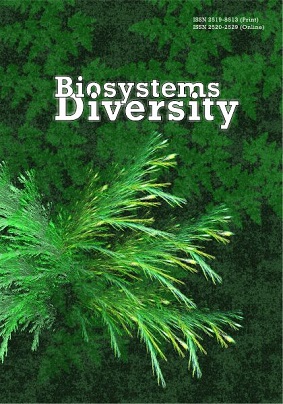Applying plant disturbance indicators to reveal the hemeroby of soil macrofauna species
Applying plant disturbance indicators to reveal the hemeroby of soil macrofauna species
Author(s): N. V. Yorkina, S. M. Podorozhniy, L. G. Velcheva, Y. V. Honcharenko, O. V. ZhukovSubject(s): Agriculture, Human Geography, Human Ecology, Rural and urban sociology, Environmental interactions
Published by: Дніпропетровський національний університет імені Олеся Гончара
Keywords: diversity; urbanization; bioindication; canonical correspondence analysis; variation fractioning;
Summary/Abstract: Hemeroby is an integrated indicator for measuring human impacts on environmental systems. Hemeroby has a complex nature and a variety of mechanisms to affect ecosystems. Hemeroby is often used to assess disturbances in different vegetation types but this concept has seldom been evaluated for animals. The role of the hemeroby gradient in structuring the soil macrofauna community was investigated. The experimental polygon was located in Botanical Garden of the Oles Honchar Dnipro National University (Dnipro City, Ukraine). There were 20 sites within the polygon. On each of them at 105 points samples of soil macrofauna were taken, soil penetration resistance, electrical conductivity of soil, depth of litter, height of grasses were measured. Within each site, a description of the vegetation cover was made. Based on the description of the vegetation, an indication of the level of ecosystem hemeroby within the polygons was conducted. In total, 48,457 invertebrate (Annelida, Arthropoda, and Mollusca) individuals of 6 classes, 13 orders, 50 families and 83 species or parataxonomic units were recorded. Phytoindication reveals that the level of hemeroby within the studied polygons varies from 34.9 to 67.2. The model V and VI from the HOFJO-list were the most optimal model of the species response to hemeroby gradient. The weighted average factor value was used to assess the optimal factor level for the species in a symmetrical bell-shaped response model. The optimal factor level of the hemeroby for the soil macrofauna species ranges from 34.9 to 66.0. Species also differ in degree of specialization to the factor of hemeroby. There was a regular change in the soil macrofauna community size and diversity in the hemeroby gradient. The limiting influence of anthropogenic transformation of the environment on the abundance of soil macrofauna community is clearly marked at the level of hemeroby above average. Species diversity of the community is greatest at moderate hemeroby level. Both relatively little transformed habitats and strongly transformed ones are characterized by lower species richness of the soil macrofauna community. The Shannon index shows a clear upward trend with increasing hemeroby. The Pielou index indicates that the main reason for this trend is an increase in community evenness with increasing hemeroby. The intermediate disturbance hypothesis was fully supported with respect to species richness. For the number of species, there is indeed a certain level of heterogeneity at which the number of species is highest. For another aspect of diversity, evenness, this pattern is not true. The evenness increases with increasing habitat disturbance. This result is due to a decrease in the abundance of dominant species.
Journal: Biosystems Diversity
- Issue Year: 28/2020
- Issue No: 2
- Page Range: 181-194
- Page Count: 14
- Language: English

